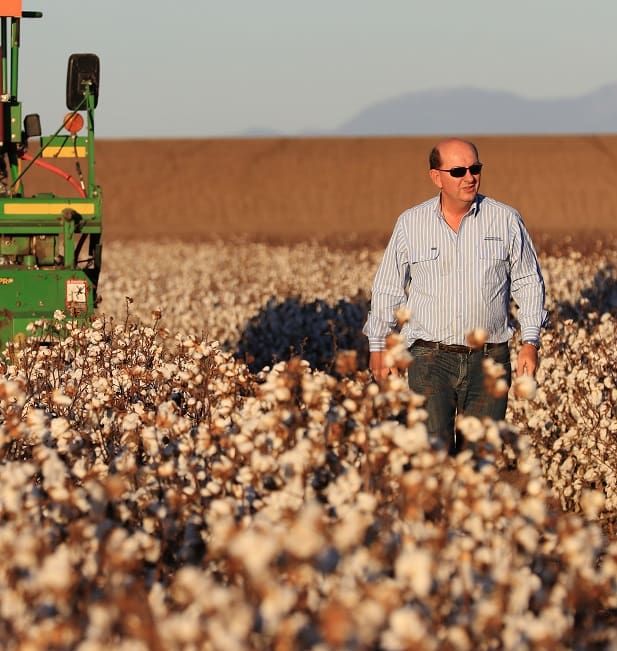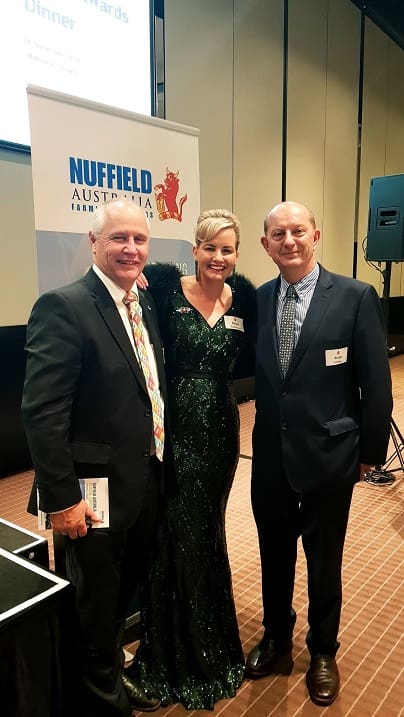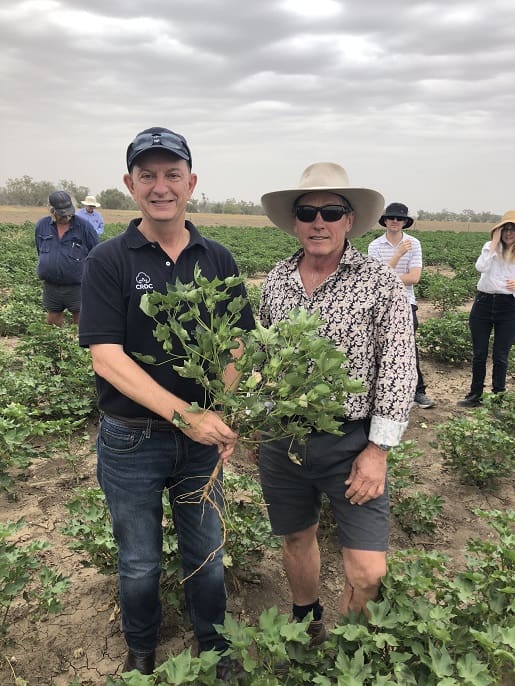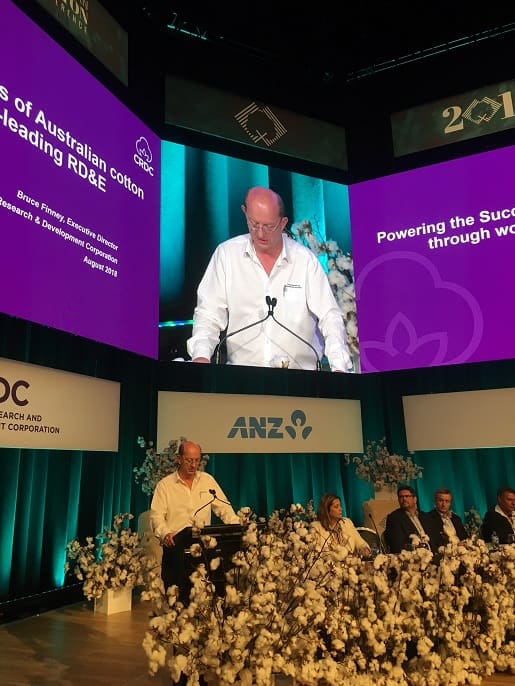
Bruce Finney will step down as executive director of the Cotton Research and Development Corporation in January, 2019.
THE Australian cotton industry has undergone dramatic change since the mid-1980s when an enthusiastic, young Bruce Finney ventured out from Sydney to work as a farm hand on a cotton farm at Moree in north west New South Wales.
Fresh from graduating with an agricultural science degree from the University of Western Sydney, he joined an industry that, at the time, was struggling with issues of pesticide overuse, environmental incidents and community hostility, but has since evolved to become one of the most switched on, dynamic sectors of Australian agriculture.
Mr Finney has been on the journey with the industry over the past three decades, building a career that has seen him rise through the agronomy and research ranks to industry leadership roles.
For the past 14 years, he has been the executive director of the Cotton Research and Development Corporation (CRDC) – a role he will step down from in January 2019 to take up a position leading business development and innovation with NSW Department of Primary Industries at Orange in central west NSW.
City kid goes bush
Growing up in Sydney, Mr Finney was drawn to a career in agriculture from an early age.
“I had the perverse idea that agriculture was like the holiday farm I used to go to on the south coast. I loved science at school and connected to agriculture on holidays,” he said.
With little experience, his first job in the industry was working as a farm hand and trainee agronomist from 1984 to 1987 on National Mutual Rural Enterprises’ Telleraga Station at Moree and Togo Station at Narrabri.
“I worked with some really interesting and capable people like Ken Arnott, Bernie George, Jack Murray and Peter Cull. They were great mentors,” he said.
“I soon got bitten by the application of science and technology to growing a crop. I loved the dynamic, progressive industry.”
In 1987, the opportunity arose for Mr Finney to take on more responsibility with Australia’s largest cotton producer at the time, the Twynam Group, where he started as a farm agronomist in the Macquarie Valley of central west NSW and later became the company’s agronomist overseeing its portfolio of properties.
In a tenure stretching over 17 years with the group, he took on various corporate management roles looking after issues of water, water reform, policy responses and managing the company’s land and water assets.
At the same time, for 11 years from 1993 to 2004, he worked with the Australian Cotton Growers’ Research Association (ACGRA) as a representative for Twynam engaged in identifying the needs and priorities for cotton research.
His growing passion for research ultimately led to him, in 2004, being appointed executive director of the CRDC, taking over from the inaugural executive director, Ralph Schulze.
In that leadership role, Mr Finney said one of the achievements he was particularly proud of was bringing the industry together during the worst of the Millennium drought in 2008 when the industry produced the smallest crop in 30 years.
“I was able to lead the development of a vision for the future of the industry, thinking beyond survival in the midst of a drought to thinking about the future of the industry in 20 years. That was a very powerful process.”
Facing up to the issues
Reflecting on the cotton sector’s transformation over the years, Mr Finney said in the 1980s and 1990s it became very clear the industry had to take responsibility for changing its practices, particularly in relation to pesticide use.

Bruce Finney (right) with Cotton Australia general manager, Michael Murray, and CQ regional manager and Nuffield scholar, Renee Anderson.
“There were unintended environmental consequences from the movement of pesticides and the insects were becoming resistant to the chemicals, so we really had to accept responsibility and make changes, which we did,” he said.
“The introduction of the Integrated Pest Management program, Best Management Practices and GM cotton all came together powerfully in the mid-1990s to provide a robust solution to the problems.
“We went from 13 sprays a year to two. And yield expectations increased. We went from an expectation of five bales/hectare back then to now at least 10b/ha, and in many cases 15b/ha.
“We know from research that half the yield gains come from genetics and half from management. All the research over the last 30 years makes it possible to achieve those high yields.”
Mature industry outlook
Mr Finney said the key to the Australian cotton industry overcoming its earlier challenges and transforming into the highly successful industry it has become was the development of a pro-active culture and the adoption of a mature, forward-looking approach.
“The cotton industry is not an industry that has been tied up by history. Since the inception of the modern industry in Australia in the 1960s it has been based on a willingness to invest in R&D, to find solutions for itself and take responsibility,” he said.
“That culture still stands the industry in strong stead today. In fact, I think the industry has become increasingly mature in its outlook. It looks outwardly at the world and thinks about the community and consumers of cotton in a way that it didn’t 20 to 30 years ago. There is a real maturity of thinking and leadership now in the industry.
“It doesn’t mean we can’t continue to improve. In fact, it is critical we keep improving. But, I’ve noticed quite a change in the maturity of the industry being far more outward looking and moving from not just collaborating when there is a problem, but collaborating to create opportunities.”
Mr Finney said another element of the industry’s strength and cohesion was the popular biennial cotton conferences which he played a significant role in organising.
Held on the Gold Coast, they regularly draw huge attendances from a wide cross-section of the industry. This year’s conference attracted 2350 registered participants.
“The cotton conferences have been an integral part. They create a sense of industry and belonging. That is really important. As much as it is about networking and exchanging ideas and information, it is a sense of belonging and that we are all in this together. That is really powerful,” he said.
Technology future
Mr Finney said the ongoing challenge for everyone in the industry was to continue to look forward, to avoid complacency and to set ambitious goals to work towards together.
“We know that trust and social licence are absolutely critical to the success of agriculture, so we have to keep working at contributing more to society,” he said.
“Technology will continue to underpin industry growth and performance. We will see what was ground-breaking in terms of biotechnology continue to grow in terms of the adoption of new technologies around digital agriculture in particular and the use of data, robotics and automation. They will be as profound in the next 10 years as biotechnology was during the 1990s.”
Mr Finney said he expected the industry to continue to expand beyond the established growing areas of NSW and Queensland into new areas, thanks to new, more widely adapted varieties and better management practices that made it possible to extend the crop’s geographic spread.
“I think it is fantastic that growers have choice to grow so many different crops, and cotton will continue to become an opportunity for more farmers in Victoria and northern Australia. We have had interest from farmers wanting to grow cotton in South Australia,” he said.
“There are also opportunities for expansion in dryland farming systems. I anticipate cotton will become a crop of choice for more farmers into the future.”
Grain Central: Get our free daily cropping news straight to your inbox – Click here



HAVE YOUR SAY